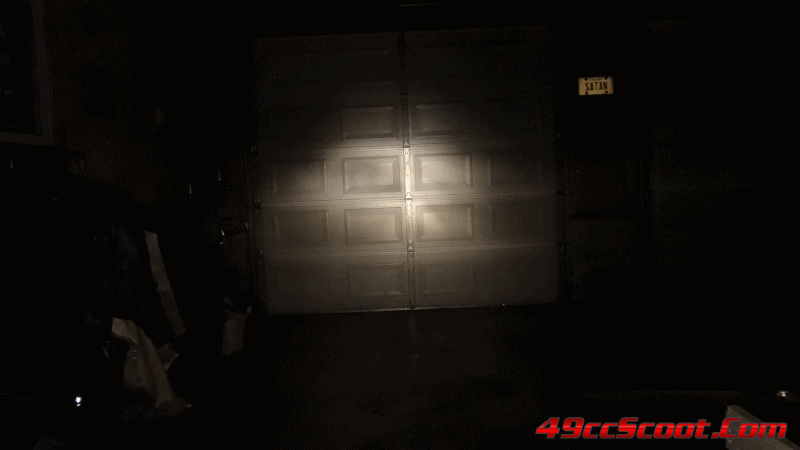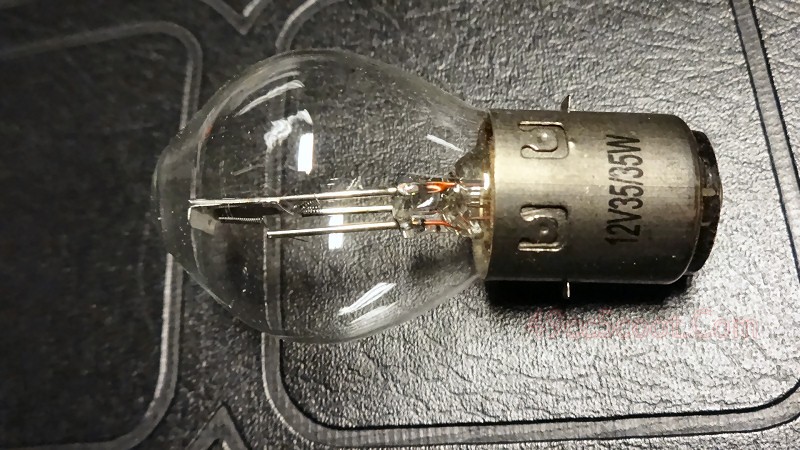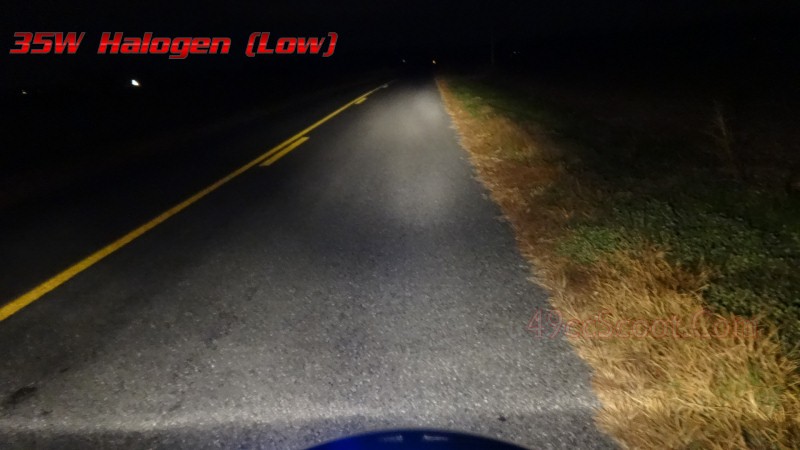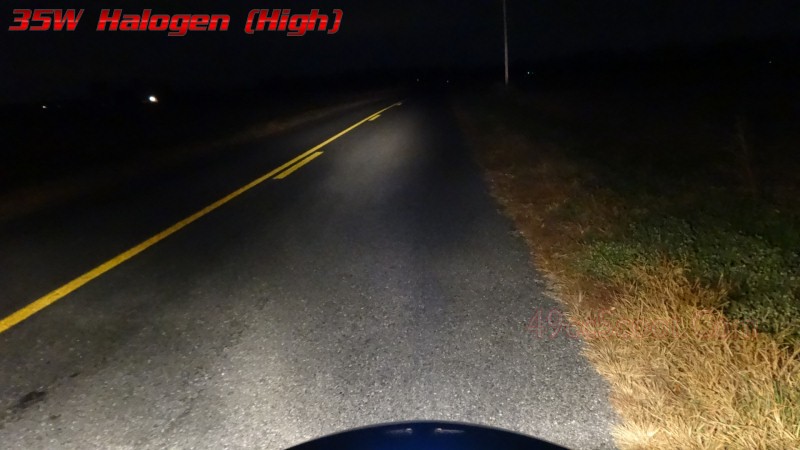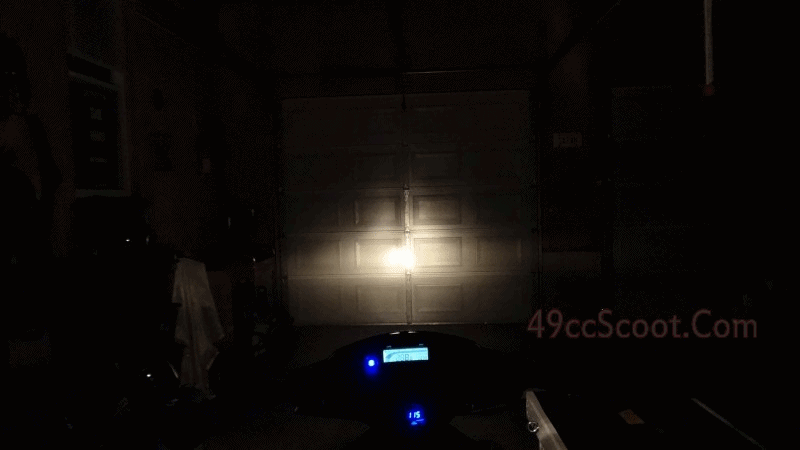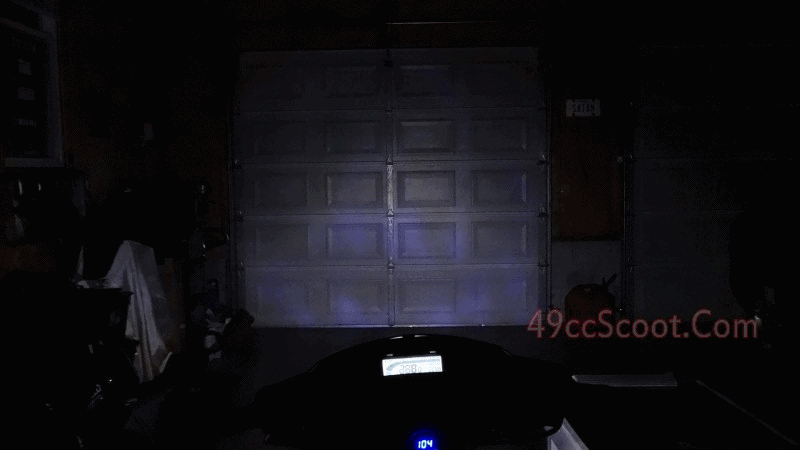BA20D / B-Base Headlight Upgrades Xenon Halogen & More Watts
Jul 3, 2013 10:57:24 GMT -5
flqu06 likes this
Post by 90GTVert on Jul 3, 2013 10:57:24 GMT -5
I ride primarily at night, so I understand the importance of good lighting. I do not enjoy riding on the shoulder while cars blind me with their high beams and HIDs while I wonder what's in front of me or having greatly limited forward or peripheral vision. I know I'm not the only one, so here's some info for anyone else interested.
The bulbs in the TaoTao ATM50-A1 are a B-base or BA20D. My stock bulb is 35W/35W. All of these are the same power low and high beam. I have seen staggered bulbs in the past, 35W/40W for example, but I can't recall where now. From left to right in the image below, 35W stock, 35W Xenon, 45W, 50W Xenon. I got the xenon bulbs on eBay and the standard style from www.bulbtown.com . I've used www.mfgsupply.com in the past for standard B-Base bulbs from 35W to 60W as well.

The standard style bulbs just come with a little cardboard around the glass, but here are pics of the packaging for the others in case it's of any use.
35W Xenon

50W Xenon

I swapped each bulb in and took pics of the light emitted at about 4,500RPM for the high and low beam of each bulb. The garage was totally dark, so all light in the pics is from the bulbs.
35W Stock
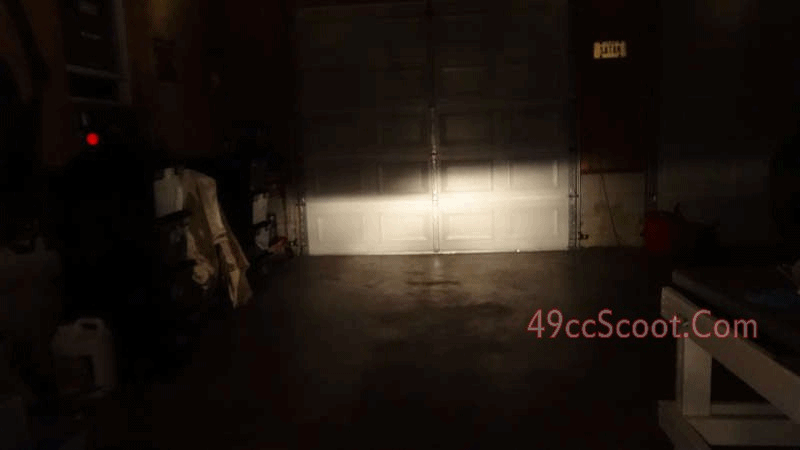
35W Xenon
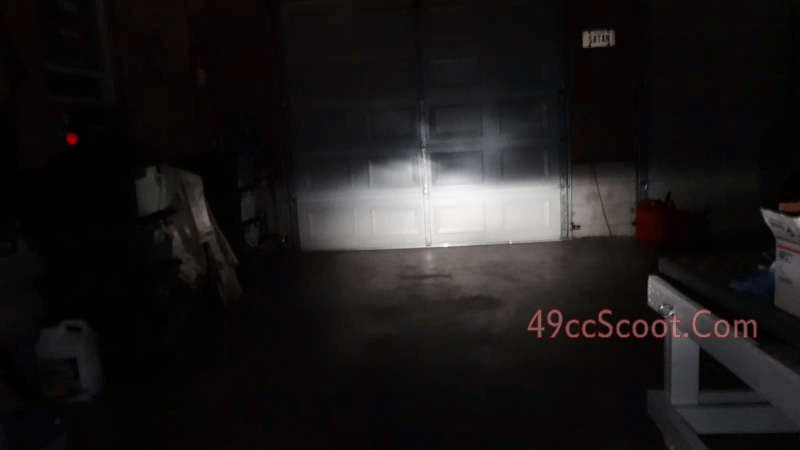
45W
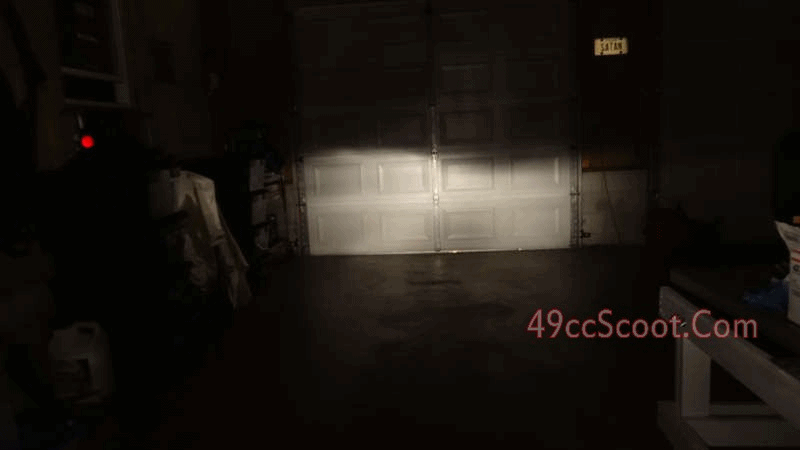
50W Xenon
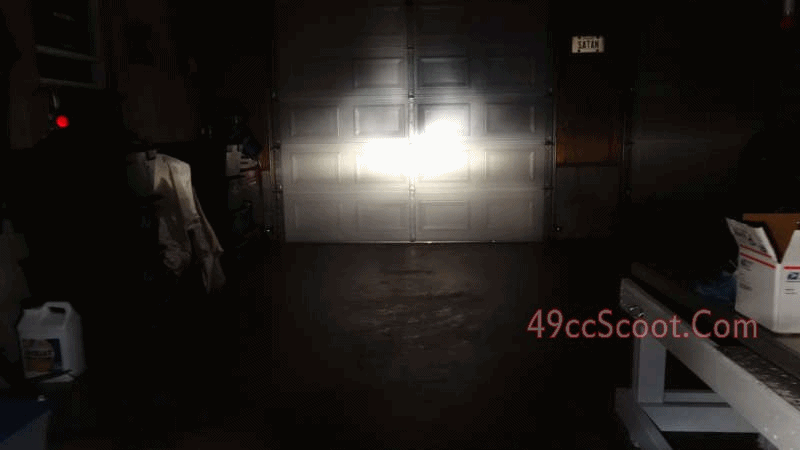
Here's a look at the 50W xenon. Both of the xenon bulbs emit a very white light. Compare it's cool color to the warmer running light below (which is very similar to the standard headlight bulb color).
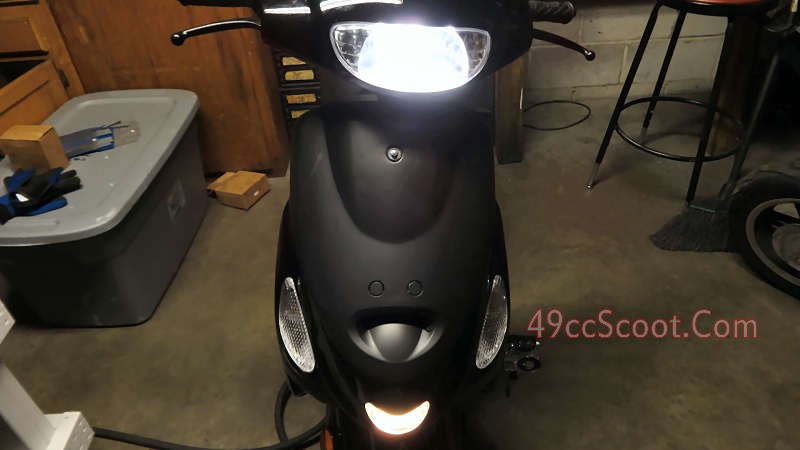
You can see that there are not only differences in intensity, but also the patterns of light. Some bulbs may need to be aimed different than others for best results. Below is an animated gif comparing the bulbs, as well as each frame individually so you can take a better look if you wish.
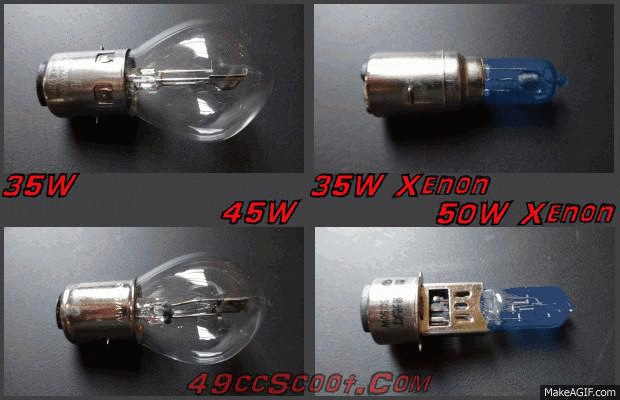
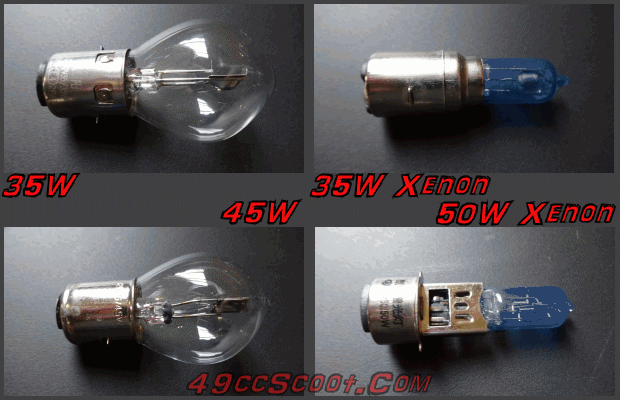
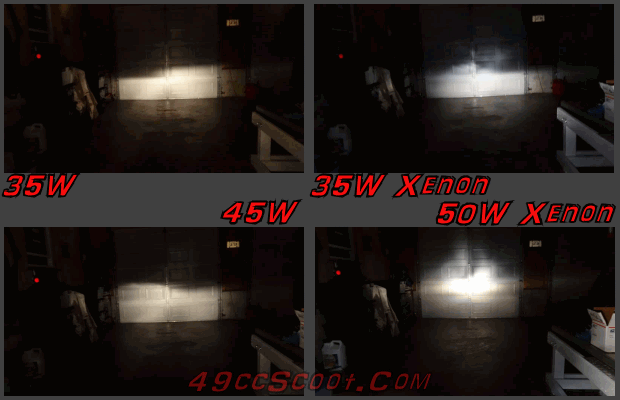
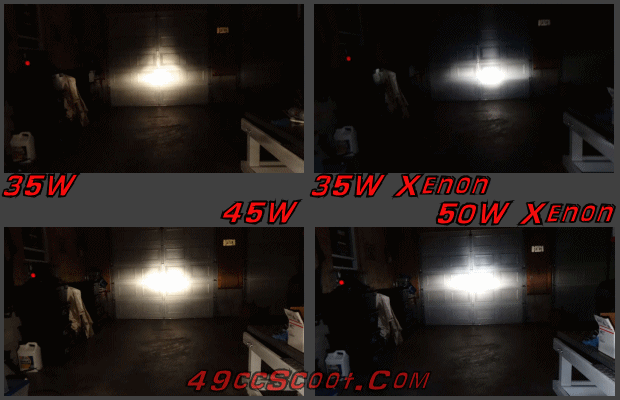
The 50W xenon bulb is the clear winner for light output. I don't think it comes across as well in the photos, but it's obvious in person. I also like the pattern it puts out.
I wish it could end there and I could say the 50W xenon is the hands down winner of the bulbs I tried. Nothing ever seems to work out that easily though.
The issue with the xenon bulbs is apparent upon installation. They just don't fit well. This is the case with both of the bulbs I have, and they are both branded different and from different sellers. They're loose in the socket and even bending the connectors at the bottom of the socket a bit to apply more pressure doesn't really solve the problem. I measured the bases of the xenons vs standard replacements. The standard bulbs have a 20mm diameter at the base, while the xenon bulbs measure just over 19mm. Additionally, when measuring from the tabs that lock the bulb into the socket down to the bottom of the connectors I found that the xenon bulbs are more shallow. The standard bulbs are roughly 16.5mm deep, while the xenon bulbs are around 15mm deep. That all adds up to bulbs that wiggle around in the socket.

The raised portions of the xenon bulbs are also smaller, to make them connect just that much worse.

The 50W xenon is just so bright and white that I had to try it out on the road, even with the poor fit. The fit worried me enough that I did carry along the 45W bulb, a flashlight, and the tools needed to change a bulb. I was very happy with the light output of the 50W xenon while riding. It really makes a huge difference compared to the 35W standard bulb. I could see farther ahead and a little wider. It also felt like both the high and low beam were very useable. With the standard bulb, only one or the other really worked for me (depending how I aimed it). The pictures above and anything I tried to take on the road don't do the actual difference justice. I was a lot more comfortable with what I could see against the lights of oncoming cars and on dark back roads. I also saw a couple of deer off to the side of the road at one point that I'm fairly confident I would not have spotted with the stock light.
Roughly 12 miles into my ride, the light went out. It didn't matter if I switched to high or low beam. I pulled over, tapped on the healight. Nothing. Sat there for a second, and it came back on it's own. This worried me a bit, but I decided to give it another chance. 3 miles later it died while I was doing 30+ on a back road with no lighting. I braked and pulled off to the side. Again I tapped on the housing. Nothing. I tapped off and on for a minute while waiting for a car to pass, still nothing. There was a complex ahead with lighting, so I opted to move ahead to it to change the bulb. Just as I pulled out of the grass, the headlight came back on. This was nice for making the trip to the lighted area, but it wasn't going to convince me the xenon deserved another chance.
I pulled the scooter up onto a sidewalk under a light and swapped out the 50W xenon for the 45W bulb. I did notice that the xenon made everything very hot. The bulb, the socket, and the housing. I had been keeping an eye on the housing anyway, and really already knew this. I was monitoring it to make sure the housing didn't start to melt. I've seen housing melt on other Chinese scooters with bright bulbs. The smaller the housing, the greater the risk seems to be in overheating the plastic. I've used 60W bulbs in scooters with larger housing for a long time with no issues, but I've also seen 50W bulbs melt smaller housings very quickly. I'm sure the quality of the plastic has a big role, but I don't know how you'd figure that out... unless it melts and then you know it sucks. lol Back to the xenon, I'm not sure if the heat it was making had anything to do with it cutting out. I would think that it would blow, or melt connections, or pop a fuse rather than cutting off and on. That said, it did strike me as odd that I could tap and beat on the housing and fairing all I wanted and it seemed to make no difference. Both times the bulb came on seemingly when it wanted to without my input being of any noticeable benefit. Then again, scooters to vibrate a lot.
With the 45W bulb in place I completed my ride without issue. I did miss the 50W xenon for the rest of the ride though. Switching back and forth you really see the change. The 45W was an upgrade from the 35W stock bulb, but it was still a big disappointment after riding with the 50W xenon headlight.
I took another look at the xenon bulb today. I thought perhaps I could add some solder to the connections on the base to help it make better contact and fit a little tighter. I can't get solder to stick to them though. I tried 60/40 rosin core and 62/36/2 silver bearing solder, with and without flux, heating the bulb vs trying to pass solder from the iron to the bulb. It rolls right off or just sticks to the soldering iron no matter what I've tried. If that had worked, I thought perhaps some foil around the circumference of the bulb as well may make it fit securely enough that it would work or I could at least rule out fitment as the cause of it cutting out.
I'm not sure if there are better versions of the xenon bulbs made or not. Both of the ones I have are made in China. If there is a version that fits well, I would buy one in 40-50W assuming the price is reasonable. Considering only light output, the 50W was a really nice bulb that I grew fond of the second I pulled onto the roadway. Heat could still be a problem, but the 45W standard design bulb had no issues with heat or cutting out. For those reasons, the 45W is what I'd have to suggest considering for now. It's an upgrade vs the stock 35W, it fits as it should, and I had no problems with the housing from the additional heat it generated. If your scooter has the 25W version of that bulb, it would probably be a huge upgrade.
While I'm talking about headlight bulbs, let me make a few more notes that may be useful to anyone not used to changing bulbs or at least not on this style of scooter.
There are two screws on the back side of the handlebar cover and one bolt in the front below the headlight. Then you have three clips on the top of the headlight and gauge fairings that will need to be gently pried apart, sort of as if you were swinging the front half upward. Look around with a flashlight and take your time to avoid breaking tabs or panels.
Don't touch the glass portion of the bulb. Use a clean rag to protect the glass when you handle the bulb.
Bulbs should simply be rotated to lock and unlock them in the housing, with a gentle pushing or pulling force. You should see that one tab on the bulb is larger than the other, so it needs to line up with the appropriate groove in the socket.
You may wish to apply dielectric grease to the connectors to keep moisture out and prevent corrosion.
Headlight adjustment can make a big difference in the effectiveness of your headlight. The adjustment screw is tough to reach with the headlight fairing installed. You can use a 90 degree bent screwdriver or remove the fairing and make adjustments.
Some adjusters screw in and out to change the aim. The TaoTao's adjustment screw needs to be loosened enough to allow for motion. Then you slide the screw forward or backward in the groove in the fairing to change it's aim.

Always keep watch on your headlight assembly if you decide to upgrade to higher powered bulbs. As mentioned earlier, there is a risk of melting the housing. Stop and look at the housing very frequently on your first ride. I'd suggest carrying the stock bulb and tools to change it. If you see any signs of melting, turn the scooter off and change the bulb back to stock. If this is done immediately, be aware that the bulb will be very hot and take precautions to avoid burns.
The bulbs in the TaoTao ATM50-A1 are a B-base or BA20D. My stock bulb is 35W/35W. All of these are the same power low and high beam. I have seen staggered bulbs in the past, 35W/40W for example, but I can't recall where now. From left to right in the image below, 35W stock, 35W Xenon, 45W, 50W Xenon. I got the xenon bulbs on eBay and the standard style from www.bulbtown.com . I've used www.mfgsupply.com in the past for standard B-Base bulbs from 35W to 60W as well.

The standard style bulbs just come with a little cardboard around the glass, but here are pics of the packaging for the others in case it's of any use.
35W Xenon

50W Xenon

I swapped each bulb in and took pics of the light emitted at about 4,500RPM for the high and low beam of each bulb. The garage was totally dark, so all light in the pics is from the bulbs.
35W Stock

35W Xenon

45W

50W Xenon

Here's a look at the 50W xenon. Both of the xenon bulbs emit a very white light. Compare it's cool color to the warmer running light below (which is very similar to the standard headlight bulb color).

You can see that there are not only differences in intensity, but also the patterns of light. Some bulbs may need to be aimed different than others for best results. Below is an animated gif comparing the bulbs, as well as each frame individually so you can take a better look if you wish.




The 50W xenon bulb is the clear winner for light output. I don't think it comes across as well in the photos, but it's obvious in person. I also like the pattern it puts out.
I wish it could end there and I could say the 50W xenon is the hands down winner of the bulbs I tried. Nothing ever seems to work out that easily though.

The issue with the xenon bulbs is apparent upon installation. They just don't fit well. This is the case with both of the bulbs I have, and they are both branded different and from different sellers. They're loose in the socket and even bending the connectors at the bottom of the socket a bit to apply more pressure doesn't really solve the problem. I measured the bases of the xenons vs standard replacements. The standard bulbs have a 20mm diameter at the base, while the xenon bulbs measure just over 19mm. Additionally, when measuring from the tabs that lock the bulb into the socket down to the bottom of the connectors I found that the xenon bulbs are more shallow. The standard bulbs are roughly 16.5mm deep, while the xenon bulbs are around 15mm deep. That all adds up to bulbs that wiggle around in the socket.

The raised portions of the xenon bulbs are also smaller, to make them connect just that much worse.

The 50W xenon is just so bright and white that I had to try it out on the road, even with the poor fit. The fit worried me enough that I did carry along the 45W bulb, a flashlight, and the tools needed to change a bulb. I was very happy with the light output of the 50W xenon while riding. It really makes a huge difference compared to the 35W standard bulb. I could see farther ahead and a little wider. It also felt like both the high and low beam were very useable. With the standard bulb, only one or the other really worked for me (depending how I aimed it). The pictures above and anything I tried to take on the road don't do the actual difference justice. I was a lot more comfortable with what I could see against the lights of oncoming cars and on dark back roads. I also saw a couple of deer off to the side of the road at one point that I'm fairly confident I would not have spotted with the stock light.
Roughly 12 miles into my ride, the light went out. It didn't matter if I switched to high or low beam. I pulled over, tapped on the healight. Nothing. Sat there for a second, and it came back on it's own. This worried me a bit, but I decided to give it another chance. 3 miles later it died while I was doing 30+ on a back road with no lighting. I braked and pulled off to the side. Again I tapped on the housing. Nothing. I tapped off and on for a minute while waiting for a car to pass, still nothing. There was a complex ahead with lighting, so I opted to move ahead to it to change the bulb. Just as I pulled out of the grass, the headlight came back on. This was nice for making the trip to the lighted area, but it wasn't going to convince me the xenon deserved another chance.
I pulled the scooter up onto a sidewalk under a light and swapped out the 50W xenon for the 45W bulb. I did notice that the xenon made everything very hot. The bulb, the socket, and the housing. I had been keeping an eye on the housing anyway, and really already knew this. I was monitoring it to make sure the housing didn't start to melt. I've seen housing melt on other Chinese scooters with bright bulbs. The smaller the housing, the greater the risk seems to be in overheating the plastic. I've used 60W bulbs in scooters with larger housing for a long time with no issues, but I've also seen 50W bulbs melt smaller housings very quickly. I'm sure the quality of the plastic has a big role, but I don't know how you'd figure that out... unless it melts and then you know it sucks. lol Back to the xenon, I'm not sure if the heat it was making had anything to do with it cutting out. I would think that it would blow, or melt connections, or pop a fuse rather than cutting off and on. That said, it did strike me as odd that I could tap and beat on the housing and fairing all I wanted and it seemed to make no difference. Both times the bulb came on seemingly when it wanted to without my input being of any noticeable benefit. Then again, scooters to vibrate a lot.
With the 45W bulb in place I completed my ride without issue. I did miss the 50W xenon for the rest of the ride though. Switching back and forth you really see the change. The 45W was an upgrade from the 35W stock bulb, but it was still a big disappointment after riding with the 50W xenon headlight.
I took another look at the xenon bulb today. I thought perhaps I could add some solder to the connections on the base to help it make better contact and fit a little tighter. I can't get solder to stick to them though. I tried 60/40 rosin core and 62/36/2 silver bearing solder, with and without flux, heating the bulb vs trying to pass solder from the iron to the bulb. It rolls right off or just sticks to the soldering iron no matter what I've tried. If that had worked, I thought perhaps some foil around the circumference of the bulb as well may make it fit securely enough that it would work or I could at least rule out fitment as the cause of it cutting out.
I'm not sure if there are better versions of the xenon bulbs made or not. Both of the ones I have are made in China. If there is a version that fits well, I would buy one in 40-50W assuming the price is reasonable. Considering only light output, the 50W was a really nice bulb that I grew fond of the second I pulled onto the roadway. Heat could still be a problem, but the 45W standard design bulb had no issues with heat or cutting out. For those reasons, the 45W is what I'd have to suggest considering for now. It's an upgrade vs the stock 35W, it fits as it should, and I had no problems with the housing from the additional heat it generated. If your scooter has the 25W version of that bulb, it would probably be a huge upgrade.
While I'm talking about headlight bulbs, let me make a few more notes that may be useful to anyone not used to changing bulbs or at least not on this style of scooter.
There are two screws on the back side of the handlebar cover and one bolt in the front below the headlight. Then you have three clips on the top of the headlight and gauge fairings that will need to be gently pried apart, sort of as if you were swinging the front half upward. Look around with a flashlight and take your time to avoid breaking tabs or panels.
Don't touch the glass portion of the bulb. Use a clean rag to protect the glass when you handle the bulb.
Bulbs should simply be rotated to lock and unlock them in the housing, with a gentle pushing or pulling force. You should see that one tab on the bulb is larger than the other, so it needs to line up with the appropriate groove in the socket.
You may wish to apply dielectric grease to the connectors to keep moisture out and prevent corrosion.
Headlight adjustment can make a big difference in the effectiveness of your headlight. The adjustment screw is tough to reach with the headlight fairing installed. You can use a 90 degree bent screwdriver or remove the fairing and make adjustments.
Some adjusters screw in and out to change the aim. The TaoTao's adjustment screw needs to be loosened enough to allow for motion. Then you slide the screw forward or backward in the groove in the fairing to change it's aim.

Always keep watch on your headlight assembly if you decide to upgrade to higher powered bulbs. As mentioned earlier, there is a risk of melting the housing. Stop and look at the housing very frequently on your first ride. I'd suggest carrying the stock bulb and tools to change it. If you see any signs of melting, turn the scooter off and change the bulb back to stock. If this is done immediately, be aware that the bulb will be very hot and take precautions to avoid burns.


